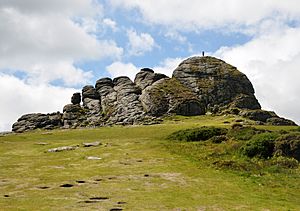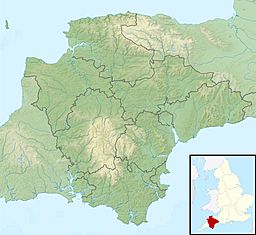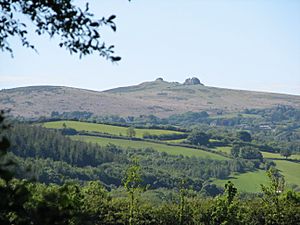Haytor facts for kids
Quick facts for kids Haytor |
|
|---|---|

The larger eastern outcrop of Haytor
|
|
| Highest point | |
| Elevation | 457 m (1,499 ft) |
| Geography | |
| Location | Dartmoor, England |
| OS grid | SX757770 |
| Topo map | OS Landranger 191 |
Haytor, also known as Haytor Rocks, is a famous tor found on the eastern edge of Dartmoor in Devon, England. A tor is a large, natural rock formation, often found on hilltops. Haytor is made of a type of rock called granite.
Contents
Where is Haytor Located?
Haytor is located near the small village of Haytor Vale. It is part of the Ilsington parish. You can find it on the map using the grid reference SX757770.
A Look Back at Haytor's History
Haytor has had many names over the centuries. Some old names include Idetordoune (from 1566) and Itterdown (from 1789). The name Haytor is quite new. It probably came from older names and the Haytor Hundred, which was an old area covering the coast between the River Teign and River Dart.
In the 1800s, steps were cut into the rock to help people climb to the top of Haytor. A metal handrail was also added to make it even easier for tourists. However, not everyone liked these changes. One person complained that the steps were for "lazy" people who couldn't climb on their own! The handrail was taken away in the 1960s because it started to rust. You can still see where it used to be.
Haytor was even a movie set! In 1953, it was used for the film Knights of the Round Table. A big castle was built between the two main rock piles for the movie. They even staged medieval sports like jousting there.
In 1974, the whole area around Haytor was sold to the new Dartmoor National Park Authority. This helps protect it for everyone to enjoy.
How Haytor Was Formed
Haytor is a classic example of an "avenue" tor. This means the granite rock between its two main parts has worn away over time. Its unique shape makes it a well-known landmark. You can see it from many places in south Devon, especially between Exeter and Totnes.
Most of Haytor is made of rough-grained granite. But at the bottom of the western rock, there's a layer of finer-grained granite. This softer rock has worn away more, creating a small overhang or rock shelter in some spots.
A special type of quartz called Haytorite was found nearby. It was named after Haytor because that's where it was discovered!
Quarrying Haytor Granite
The granite found below Haytor was very good for building. It had fewer large crystals than the rock at the top of the tor. Several quarries (places where rock is dug out) were active on the northern slopes of Haytor between 1820 and 1919.
From 1820 to 1858, the rock from these quarries was moved using the Haytor Granite Tramway. This tramway was special because it was built out of the very granite it was designed to carry! Because granite is so strong, much of the old tramway can still be seen today.
Haytor granite was used to rebuild London Bridge in 1831. This famous bridge was later moved to Lake Havasu City in Arizona in 1970. The last rock taken from Haytor in 1919 was used for the Exeter war memorial.
Haytor Today
Haytor's rocks and quarries are now protected as a Site of Special Scientific Interest. This means they are safe from building and other disturbances. Haytor is considered one of Dartmoor's most beautiful and famous spots. Many people visit it, including walking groups and coach tours.
You can easily reach Haytor by road. It sits at 457 meters (about 1,500 feet) high on the eastern side of Dartmoor. From the top, you get amazing views of the coastline, the Teign Estuary, and the rolling countryside. In 2013, a writer named Simon Jenkins said the view from Haytor was one of the top ten in all of England!
The smaller rock outcrop on the western side is sometimes called "Lowman." Both parts of Haytor are popular with rock climbers. They offer different climbing routes for various skill levels.
The road that goes below Haytor has also been part of big cycling races. It was a finish line for a stage of the 2013 Tour of Britain and again for the 2016 Tour of Britain.
Images for kids







